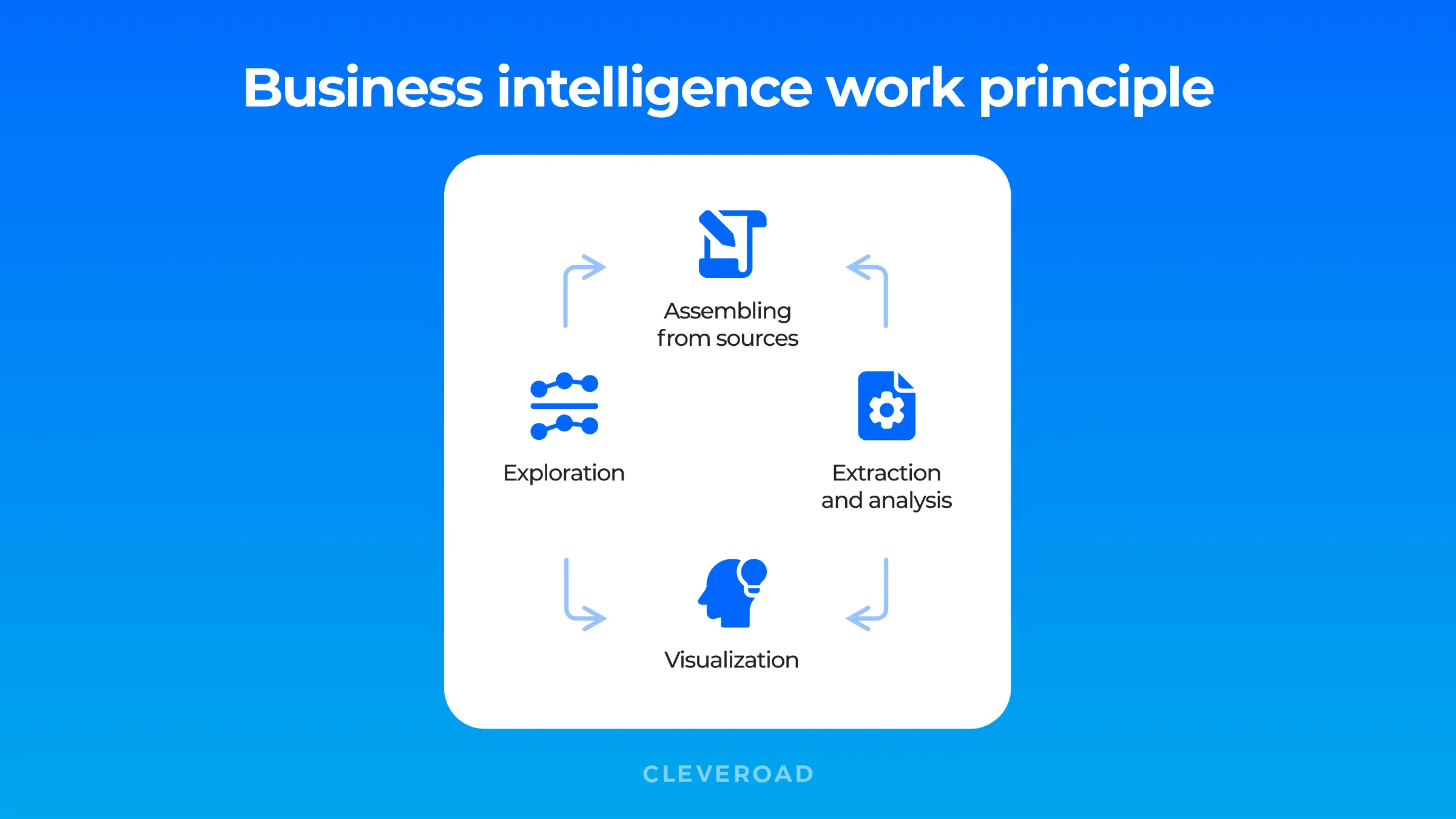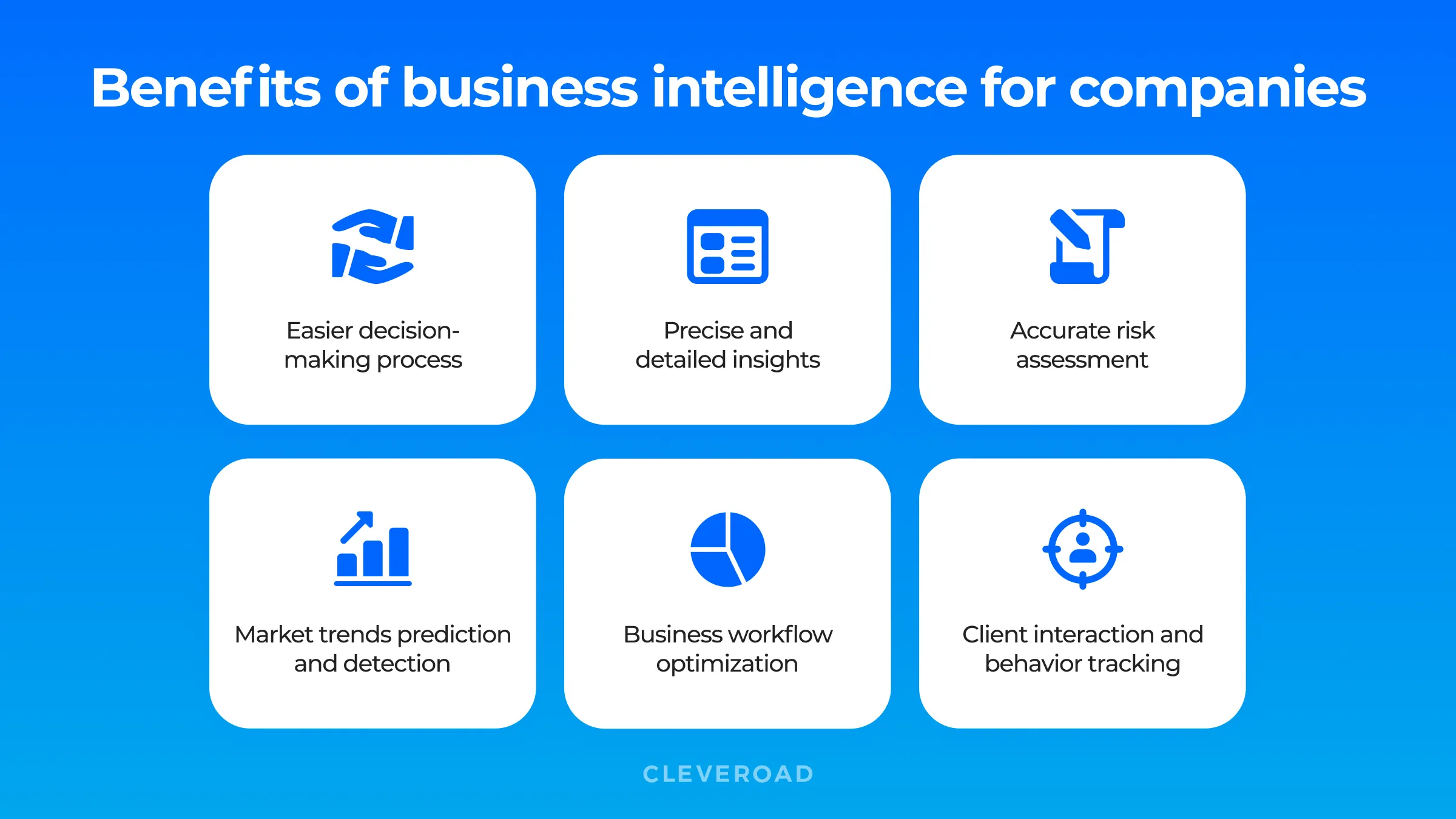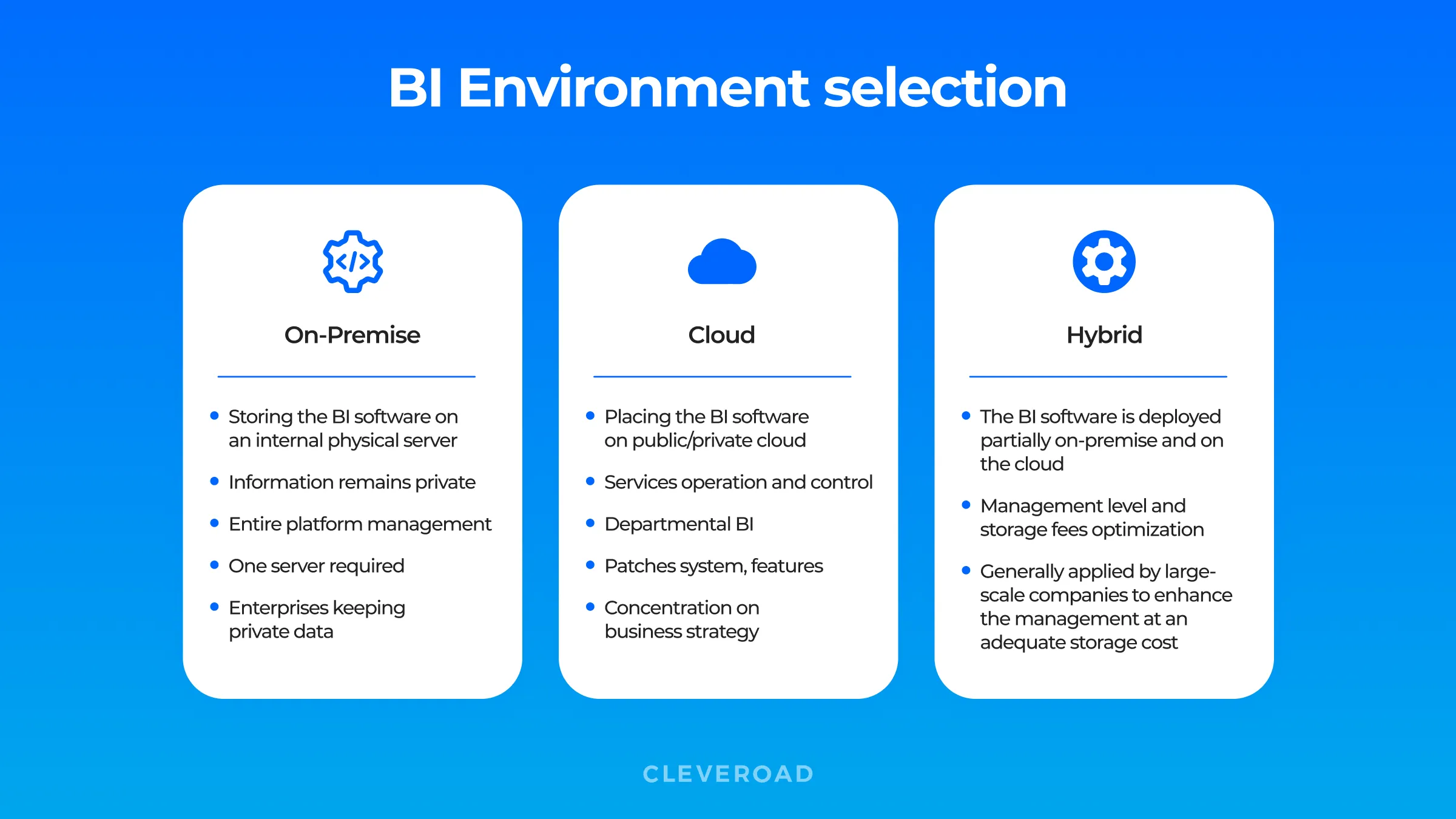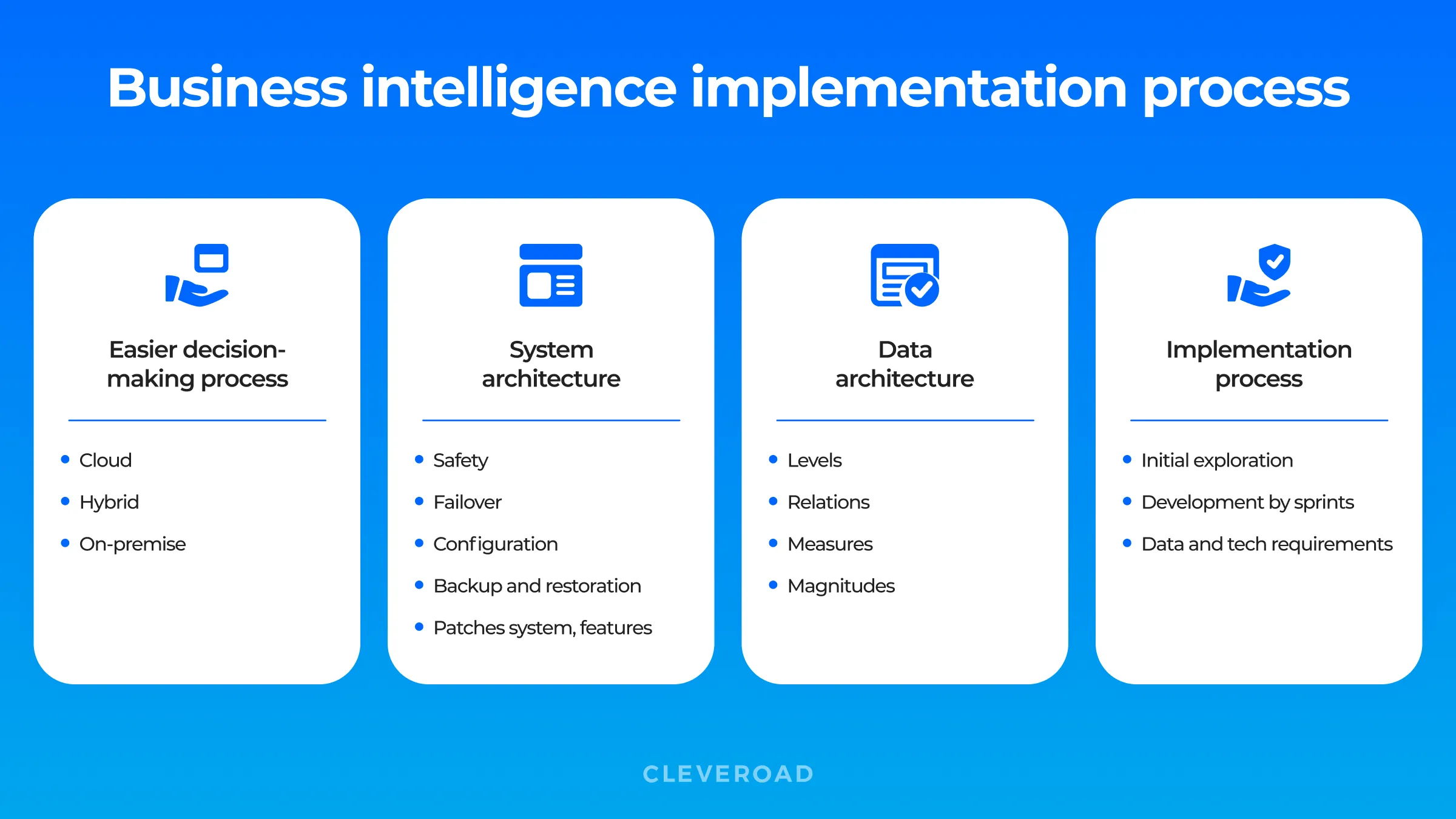Implementing Business Intelligence in 2025: The Utter Roadmap
Updated 10 Mar 2023
19 Min
1836 Views
Large-scale businesses process loads of data daily. It covers analytics concerning their spendings as well as statistics of interaction with customers and other business-related indicators. Business intelligence (BI) implementation is an excellent way to maximize data efficiency, optimize your company’s internal processes, detect its weak spots and enhance them.
By applying this solution, companies are able to increase profits, ease the decision-making process, and receive a row of other benefits. Three years ago, the global business intelligence market size amounted to $20.60 billion and is forecasted to surmount $39.35 billion by 2027 with a CAGR of 8.5% during the stated period, defining the effectiveness of this solution.

BI market revenue in North America (USD Billion)
In this article, we’ll discuss how to implement business intelligence successfully, describe its significance and advantages for businesses, development stages, and essential tools required for this complex process.
What is Business Intelligence
Business intelligence refers to a set of instruments, applications, and solutions useful in rough business data gathering and the following analysis to take advantage of it. BI solutions commonly comprise advanced analytics, like data collecting, predictive analytics, text mining, statistical analysis, and big data analytics. Self-service business intelligence environments provide an opportunity to request statistics, design analytics visualizations, and customize dashboards.
From the beginning, these instruments were fundamentally applied by BI and IT experts to conduct queries and form reports for people in business. However, nowadays, the implementation of business intelligence is widely applied by business analysts and company owners as well, due to the progress of self-service BI and data-gathering instruments. Self-service business intelligence environments provide an opportunity to request statistics, design analytics visualizations, and customize dashboards.
According to the statistics, the worldwide BI market value amounted to $22.16 billion in 2020 and is forecasted to reach $42.95 billion by 2028: more and more entrepreneurs apply such a useful tool for company progress.
Successful business intelligence/data warehouse implementation involves not only a plain application. It comprises an instrument kit, software, and technologies allowing to extract raw data to analyze and explore it onward. It primarily includes clients’ behavior and purchasing patterns and the information useful for developing progressive business strategies. Studying all this data is helpful to personalize services, define modern approaches to raise sales as well as profit, conclude precise forecasts, and lots of other actions for company expansion.
After defining what is business intelligence, let’s clarify what it comprises:
- Performance tracking and operation
- Forecasting modeling
- Analytics
- Data gathering and others
The primary motive of companies for implementing business Intelligence is data analysis. BI gathers data from all the times the company exists to come up with the most efficient solutions and decisions.
BI uses different analytics methods, including:
- Data gathering implies automated analysis of vast data loads to detect patterns
- Text analytics extract rough data with the same goal. It may be applied for linguistic analysis, social media sentiment analysis or client reviews, and many more
- Business analytics explore the obtained statistics and detect business strategy flaws, client behavior, and interaction patterns for further enhancement

The concept of business intelligence operation
Types of Business Intelligence tools and applications
Business intelligence is a combination of a broad set of data analysis applications designed to meet different information needs. Most are supported by both self-service BI software and traditional BI platforms. The list of BI solutions that are available to companies includes the following:
Ad hoc analysis
It’s a basic component of modern BI software and a primary functionality element of self-service BI instruments. The main aim is to draw up and conduct queries to explore certain organizations’ parts. Ad hoc queries are commonly created on the fly, are carried out systematically, and analytics results are incorporated into reports, statistics, and dashboards.
Online analytical processing (OLAP)
OLAP is among the first BI instruments. It allows decomposing data by several dimensions, which is especially great for complex queries and assessments. Earlier, the data was collected from the data warehouse and placed in multidimensional OLAP cubes, yet, now there’s an opportunity to conduct OLAP analysis directly against columnar databases.
Why is this tool significant? Read more about enterprise data warehouse as the state-of-art BI tool
Mobile BI
Mobile business intelligence allows using BI software on mobile gadgets. It is applied less for visualization and more to just open the application on the phone. Mobile BI instruments are generally built more easy-to-use and handy. Mobile dashboards allow opening only two or three data visualizations and KPIs to make them readable when using the phone screen.
Real-time BI
Real-time BI applications imply data assembling, analysis, and processing as soon as it’s produced. Thus, people in business keep up with the freshest statistics. The real-time analytics also enable processing streaming data and supports decision analytics uses, such as credit scoring, stock trading, and targeted promotional offers.
Operational intelligence (OI)
Operational BI is another model of real-time analytics that ensures managers and frontline staff with information about business processes. OI applications’ primary purpose is assisting operational decision-making and allowing overcoming business challenges more efficiently.
Software-as-a-Service (SaaS) BI
SaaS BI tools use cloud computing systems managed by providers to ensure data analysis opportunities to businesses by way of a service that's typically priced on a subscription basis. Named cloud Business Intelligence either, the SaaS model primarily offers multi-cloud support, which allows enterprises to launch BI applications on different cloud platforms for user satisfaction and provider lock-in prevention.
Open-source BI (OSBI)
Open-source BI commonly comprises two versions:
- A community edition that can be used free of charge
- A subscription-based commercial release with technical maintenance by the vendor The source code is available for BI specialists for development matters. Besides, some providers of proprietary BI instruments provide free editions, mainly for individual clients.
Embedded BI
Embedded BI instruments place BI and data visualization features into business applications. It allows enterprise owners to analyze data within the applications they apply for task fulfillment. Embedded software development is typically offered by application software providers, but corporate software developers can also implement them in homegrown applications.
Collaborative BI
It concerns a process rather than certain technology. The collaborative software involves a set of BI solutions and collaboration instruments to enable users fulfilling data studying and analysis in partnership and share information. For instance, users can leave notes on BI data and final analytics with comments, queries and discuss gathered statistics by means of online chat and other communication instruments.
Location intelligence (LI)
Location intelligence enables exploring and analyzing the location and geospatial data, with a map-based data visualization feature. This software is able to provide insights on location components in business data and administration. Feasible efficiency incorporates site selection for retail stores and corporate facilities, location-based marketing, and logistics management.
Why Use Business Intelligence
The fundamental purpose of a business intelligence system is to provide statistics concerning business indicators. Analysts apply BI to track capacity and rivals’ direction vector to maximize the business strategy efficiency. Besides, with BI, specialists can define market trends to increase sales and revenue. Consequently, business intelligence implementation is a way to profit from data assembled more.
Why business intelligence is important? Let's observe the following list of opportunities and functions it comprises:
- Detect methods to raise profit
- Study client behavior
- Compare analysis with the competitors’
- Observe performance
- Optimize workflow
- Make forecasts and proper decisions
- Identify market trends
- Detect company’s flaws and drawbacks
You should think over the BI implementation in case your business goes through:
- Insufficiently productive staff
- Clients outflow
- Wasted resources and time
- Under/overstocking
- Vast data amount with no further usage
Why Business Intelligence is Important for Business
The main reason why business intelligence is important for companies of any scale is that it efficiently helps in making business-related decisions based on the prepared analytics and statistics. Thus, BI is the ultimate way to enhance the organization’s performance. Enterprise owners are able to distribute their resources wisely and accurately, detect the company’s weaknesses and get rid of them.
Let’s cover the other benefits more precisely:
Proper decision making
In some cases, graphics and charts in dashboards can’t serve as a comprehensible picture of your business performance. Visualization simplifies the process of data perception, so it’s easier to find out business drawbacks, weak spots and track the latest market trends.
Precise reports
Another reason why use business intelligence is that it processes various types of data to conclude accurate reports, visualize them, or prepare information in written format. Thus, the enterprise owner will be aware of all the changes in the company’s progress and other indicators.
Identify trends
BI can study markets of various domains, competitors from your niche, spot benefits and drawbacks of your company, and detect trends. As a result, you’ll be the first one who is aware of modern tendencies and make use of this privilege. A great example of this benefit is the supply chain business intelligence which is a useful technology for making forecasts for the logistics market.
Risk management
There are certain risks in every business niche. Danger may be caused by cyber threats, data leaks, etc. BI is a solution to decrease those risks and protect sensitive data and prevent fraudulent actions. To illustrate, fintech institutions apply BI to develop secure intelligence platforms, minimize fraudulent actions and cyber attacks.
Budget
Due to the diversity of benefits provided by BI, it may appear to be quite costly. Yet, you can be sure that the investments BI requires will be quickly recouped. With provided opportunities, it’ll be much easier not only to make profitable business decisions and progress your business strategy but also to enhance performance or cut down costs and resources by detecting areas where they can be decreased. Thus, your income will increase with BI. Besides, some BI instruments are completely free of charge, like Google data studio.
Data accessibility
Some business data is easily accessible and doesn’t require any extractions or other actions. It may be gathered from the initial storage quickly (e.g., google docs) by the BI instrument. Next you have to study the numbers, explore and visualize the info to profit from BI.
Time efficiency
Data visualization speeds up information comprehension and perception. Thus, all the team members observe the statistics and understand them much faster.

BI advantages for companies
Business Intelligence Implementation Steps
It’s high time to cover the main BI implementation steps:
Step 1. Business intelligence implementation roadmap
Drawing up a detailed, thorough plan on business intelligence implementation will cut down the development time, make it easier to define the required functionality, and identify essential dimensions.
Defining goals
The primary step of the preparation phase comprises detecting your aims of BI implementation. It may be business scaling, enhancing the goods and services delivered to customers, increasing the income, improving business strategy, and many others. Parallelly with these questions, you should make up a row of requirements which will help you to achieve those targets.
Setting KPIs
To make progress tracking and observation easier depending on your business niche, it would be useful to detect KPIs (key performance indicators). They should be measurable, transparent, and comply with objectives you’ve set before. Your goals and requirements should be in the specifications document. Here are the questions to identify KPIs:
- What data resources will you apply? (CRM, ERP, website analytics, external sources, etc.)
- What type of data will be gathered for analysis? (sales numbers, reports, website traffic, etc.)
- For whom should this data be available? (managers, market analysts, other positions)
- What report types are required? (spreadsheets, diagrams, ad hoc reports, or interactive dashboards)
- What are the methods to track progress?
Gather and assign a team
The next stage is providing your team with the required scope of work. You should train and mentor the team as well as clearly explain what should be completed by each specialist and why.
Order BI creation from experts
Cleveroad developers are ready to consult you on building a sophisticated BI software
When it comes to team selection, in case you don’t have one, there are the three main hiring options:
- Freelancers. Despite the lowest cost of this option, it has a row of drawbacks that make it inappropriate for the successful implementation of business intelligence. To start with, you have to verify the freelancers’ competence yourself. Besides, such specialists often require prepayment and may simply quit your project development when they receive the money. Moreover, language barriers, time zone and cultural differences, poor self-management skills, and communication issues may arise. Therefore, you should carefully check the portfolio, rates, and reviews when hiring a freelancer.
- In-house team assembling. This model is beneficial for team proximity and excellent communication, as all the specialists are gathered in one office. Yet, this option is extremely costly as it requires paying salaries, covering office rent, purchasing qualitative hardware, and many other expenditures. Besides, you are responsible for hiring app developers and verifying their skills.
- Outsourcing companies. Many businesses have already chosen to outsource their projects and BI implementation as well. This is conditioned by the fact that outsourcing companies take over all the development-related responsibilities and charge clients only for the work done. Since such vendors are remote, they already have an office as well as a complete team of skilled specialists with proven in-depth experience.
The outsourcing option allows cutting down both product development investments and time-to-market. Yet, the team’s performance remains brilliant. The highly popular outsourcing tech hub is Eastern Europe, particularly Ukraine. This country has a huge talent pool and a wide range of great market offers. What’s more, the prevalent number of tech-savvy experts are fluent English speakers as well, which is a vital benefit.
Check our article to find out more about why Ukrainian IT outsourcing is an excellent opportunity to apply
Mentioning outsourcing, there are some options that you may use for your project:
Partial outsourcing of tech tasks
Employing a specialist to fulfill implementation, maintenance, and other services for BI software. With this model, you must possess well-developed management skills to complete the project and organize the team.
Full project outsourcing
With entire product development outsourcing, you’ll be free of both tech and non-tech development responsibilities, as a team of top-notch specialists will complete the entire project. Besides, the software development services costs are decreased, yet, the performance and product quality remain flawless.
Step 2. Choosing the type of BI software
One of the challenging business intelligence implementation steps is selecting the suitable type of BI software. The prepared specifications, aims, and the industry of your company allow detecting the suitable one among the range of existing BI solutions or go for a from-scratch software development implementing features and functionality required for your business goals completion.
After detecting which BI solution is suitable for you and assembling a list of requirements and features in the specification document, you should explore the BI market and observe the existing solutions. In case some BI software offers a free trial, it’s a great opportunity to check it out.
The following stage, after completing all the necessary preparations, is directly the business intelligence implementation process; let’s consider it in detail:
Step 3. Business intelligence implementation process
In case you’ve responsibly completed the previous phase, the implementation process will be smooth and not that complex as it may seem. The following list describes essential steps to take for successful BI implementation:
Cleaning, processing, and analyzing the data
To maximize the analysis and statistics efficiency, you should comb your data. This process implies fixing or removing incoherent, imprecise, or obsolete info. Make sure the lacking dimensions are replaced with bogus values (e.g., n/a for categorical or 0 for numerical values).
You should make sure that there are checkpoints to assess the data quality at the appointed intervals. With an efficient data cleansing, your targets become easier to reach. Next, data processing techniques have to be built. They involve developing a processing roadmap and enhancing the quality of the responses and request completing time. After that, you should integrate the BI analytics instruments directly, such as Power BI, Cognos, or Tableau to extract the useful analytics.
Making adjustments
BI solutions should scale parallelly with your business expansion. Thus, you may launch all the elements of primary significance first and keep enhancing your software. As a result, the implementation process will happen much faster, and the further adjustments will be highly precise and business-focused.
Training employees
The next stage is the complex process of studying BI implementation by your team. A prevalent number of people perceive innovations with difficulties. First things first, you should expound on the motives why to implement business intelligence, its significance, values, and assist the employees in obtaining new knowledge by instructing and leading them.
Step 4. Profiting from the BI
After completing all the actions mentioned above, you may proceed to take advantage of the BI software: gathering and analyzing data, visualizing it, and using the final results to optimize business processes, enhance business strategy, divide resources and investments reasonably and correctly. When the primary list of aims is accomplished, you may set the new ones and develop the ways and approaches to achieve them using business intelligence.
How to Implement Business Intelligence
Let’s discuss the business intelligence architecture implementation more precisely, as it also is full of peculiarities.
Step 1. Infrastructure, environment, and platform selection
Selecting the data storage is a primary step in case you’re lacking the infrastructure. Data warehouse is considered the most appropriate option for business intelligence implementation since it ensures an analysis of connected data gathered from both online transaction processing (OLTP) systems as well as business apps (e.g., ERP, CRM, and HRM systems). Yet, many companies apply both data storage models, optimizing the BI software productivity.
Next, when implementing the BI solution, you should select the proper environment for it: On-Premise, Cloud, or Hybrid environment. To make the correct decision, you should answer the following questions:
- What are your business goals?
- What are the current business conditions?
- What do you need from the BI software and the prepared analysis?
Here are the characteristics of each option:

BI choosing BI environment
When considering a Cloud environment, you should select a BI hosting provider. It would be useful to possess an architect present when looking for a provider. The most widely applied platforms to choose from are the following:
- AWS (Amazon Web Services)
- Microsoft Azure
- IBM Bluemix
- Google Cloud
The BI environment may vary in the future, so you should negotiate the flexibility in terms of changing the environment.
Step 2. System architecture: plan availability
BI has to be accessible for everyone aiming at proper decision making. Work with the business and plan accessibility collaboratively. Keep a correlation of availability and resources balanced. High accessibility is impossible without considerable spendings and resources, whereas no financial investments in availability can affect decision-making capability.
BI and the involved data are like water and pipes, which are both required to ensure expanded software opportunities. Plan for availability in your data warehouse, data marts, and ODSs while you plan for BI availability. All in all, BI is an internal software rather than a client-interacting one (unless you access BI to consumers). Sufficient accessibility may be great for your information requirements.
Configuration
- Use the application parameters for BI software optimization.
- Configure relation of the data: data warehouse, ERP, CRM, etc.
- Configure the connectivity among your subjects: PROD, DEV, TEST, etc.
- Detect the BI software's content database. A content database is an application database that stores the artifact, user, and permission definitions for the BI platform.
Version, patches, and feature management
Particular BI software requires a specific kit of operating system patches and BI application versions for correct operation.
Some technical maintenance needs the exact patch combinations creation as well. BI specialists prosper in creating new versions to provide new features and fix bugs. Your software development team has to keep up with the releases and ensure the BI solution which supports the newest ones.
Security
We’ll describe the two existing approaches to building solid protection when implementing the BI software. Yet, they may be created in combination.
Application security
Your BI software comprises native safety features. Make sure you leverage them fully.
- Authentication: verifying the users’ identity.
- Authorization: providing the authenticated users with the correct permission.
- Role-based security: a matrix structure that detects which permission a user has according to the role.
- Content-based security: content-level protection ensuring the content to specific individuals.
Enterprise security
BI safety system serves as an element of entire enterprise software protection. So you should verify if the business intelligence security is suitable to be integrated into the general corporate server security, infrastructure security, and environmental security.
Step 3. Data architecture: create your BI building blocks
BI integral architecture, such as dimensions, metrics, pecking order, and relations, must be created prior to applying them to build BI functionality such as reports, dashboards, and self-service datasets. The building blocks are useful for BI programmers and BI clients to shed light and rearrange data correctly.
Dimensions
Dimensions are commonly business-related units: clients, products, regions, suppliers, employees, time, etc. They are customized according to your industry.
Metrics
Named measures as well, refer to numerical evaluations which will be comprised in statistics and reports. Absolute numbers, monetary values, ratios, percentages, etc. are metrics. When the measures are ready, you can build assessable metrics to evaluate existing magnitudes.
Hierarchy
So-called levels enable conducting data analysis by consolidating the gathered statistics by value ranking. The drill-down function is founded on hierarchy. Illustrations of the hierarchy are location levels, groupings, product categories, time, and client classes.
Relationships
Magnitudes are related to each other. Relationships may be one-to-one, one-to-many, and many-to-many. Relationships may be obligatory or optional as well. With identified relationships, BI solutions are able to make correct requests, assemble and combine data properly, and extract it optimally.

BI architecture implementation
The solid BI architecture should follow the principles below:
- Symmetry. The architecture complies with the company’s processes. As a result, the statistic will be relevant to internal business purposes.
- Detaization. Data is extracted maximally granularly and indicates the same precision as the data from the resources. Thus, no info will be lost in such thorough statistics.
- Synchronization. The data refresh rate in the data warehouse as well as statistics should comply with the frequency of events in the pertinent business processes.
- Maintainability and scalability. The estimates, the system, and its logic behind KPIs, and assessed dimensions should be registered in the joint place (one platform, ensuring high scalability).
BI Implementation Cost
The cost of a BI implementation project, which involves developing a data warehouse, OLAP cubes, reports, and dashboards, is indicated by the complexity of the BI system, business scale, and a row of other cost-forming factors, the main of them are the following:
- Data resources quantity (ERP, CRM, HRM, EHR, e-commerce software, etc.).
- Data amount
- The number of data tables and columns used for analysis
- Complexity of the data cleanse process
- Analytics type, the number of machine learning algorithms
- Number and complexity of reports
- Number of dashboards
- User permission system complexity
- Leveraging Big Data analytics (yes/no)
The company’s structure size impacts as well, so let’s observe how the price varies according to the number of teammates (please note, that this estimate does not comprise monthly software license fee and other systematic fees):
- $80,000 - $200,000* – for companies with 200 – 500 employees
- $200,000 - $400,000* – for companies with 500 – 1,000 employees
- $400,000 - $1,000,000* – for companies with 1,000+ employees
Let’s now calculate the cost due to the time required for the BI implementation:
- Development- 3-4 months (2190- 2920 hours)
- User training- ~ 2-4 weeks (336- 672 hours)
- Launch- 2-3 weeks (336- 504 hours)
The estimate is made according to $50 hourly rate: $143,100- $204,800
| Position | Hourly rates ($/h) |
Project manager | 30-55 |
Business analyst | 25-50 |
Solution architect | 45-65 |
Business intelligence developer | 35-55 |
Data engineer | 44-62 |
Quality assurance engineer | 25-40 |
DevOps engineer | 40-65 |
Such solutions are quite complex, therefore, your technical partner should have considerable BI expertise, as the final result fully depends on specialists who work with you. As a result, you may check sources like Clutch or GoodFirms to explore vendors’ portfolios and the verified feedback from previous customers.
Cleveroad Expertise
Cleveroad is a software development company with headquarters in Ukraine. Our experience comprises delivering full-cycle web and mobile app software engineering services for more than 10 years. Cleveroad is competent in the most sought-after domains, like e-Commerce, Streaming, and Healthcare software development services. We have an individual approach for every project and provide our customers with a range of benefits:
- Thorough research conducted by our business analysts and free project estimate
- Honesty is an indispensable part of the cooperation our clients and our teammates
- A variety of flexible partnership models suitable for every case
- Full-cycle software development and ensuring top quality of your solution
- Utter team structure comprising all the essential high-qualified specialists
Cleveroad professionals are experienced in BI implementation and are ready to help you with your project as well. You’ll be provided with a thorough consultation and a top-quality BI solution.
Enhance your business with BI
Book a free call with our Senior Delivery Manager to receive a consultation on BI implementation
Business intelligence (BI) refers to a kit of instruments, applications, and solutions useful in rough business data gathering and the following analysis to take advantage of it. Business intelligence solutions commonly comprise advanced analytics, like data collecting, predictive analytics, text mining, statistical analysis, and big data analytics.
BI uses different analytics methods, including:
- Data gathering implies automated analysis of vast data loads to detect patterns
- Text analytics extract rough data with the same goal. It may be applied for linguistic analysis, social media sentiment analysis or client reviews, and many more.
- Business analytics explore the obtained statistics and detect business strategy flaws, client behavior, and interaction patterns for further enhancement.
The main reason why business intelligence is important for companies of any scale is that it efficiently helps in making business-related decisions based on the prepared analytics and statistics. Thus, BI is the ultimate way to enhance the organization’s performance. Enterprise owners are able to distribute their resources wisely and accurately, detect the company’s weaknesses and get rid of them.
Successful business intelligence implementation involves not only a plain application. It comprises an instrument kit, software, and technologies allowing to extract raw data to analyze and explore it onward:
- Performance tracking and operation
- Forecasting modeling
- Analytics
- Data gathering and others

Evgeniy Altynpara is a CTO and member of the Forbes Councils’ community of tech professionals. He is an expert in software development and technological entrepreneurship and has 10+years of experience in digital transformation consulting in Healthcare, FinTech, Supply Chain and Logistics
Give us your impressions about this article
Give us your impressions about this article